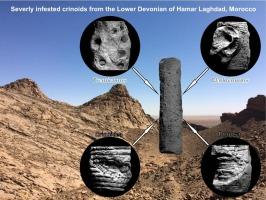摩洛哥的下泥盆世海红类多柱状生物被硬结菌严重侵染:冈瓦纳北部陆架寄生虫暴发的证据
IF 7.2
1区 地球科学
Q1 GEOSCIENCES, MULTIDISCIPLINARY
引用次数: 0
摘要
自古生代早期以来,潜行海鲷为各种外生和内生生物(硬结生物)的附着提供了独特的基质,因此它们可以获得悬浮的食物颗粒,并且不会与它们下面的海底底栖滤食性生物竞争。然而,许多外生的殖民者部分被海蚕体嵌入,因此,在寄主的生命中,协同生物相互作用可能在化石记录中被独特地保存下来。文献中报道了许多菊科植物与硬骨生物的关联及其共生关系;然而,以往的研究主要集中在特定的外生定殖体上。在这里,我们对摩洛哥Hamar Laghdad著名地区的下泥盆世(Pragian)海百合的整个殖民者组合进行了全面研究,提供了一幅独特的海百合-硬结生物共生和共生的广阔画面。我们发现超过一半的多柱Schyschcatocrinus在体内定植。最丰富的共生体是:Tremichnus产生坑的附生体(在43%的寄主海百合中发现),不同的生物收缩和具有瘿/肿胀的茎。此外,一些海百合、表珊瑚和绉珊瑚被寄主的体嵌入。与来自其他地点的cricrid - sclobit关联相比,来自Hamar Laghdad的关联显示出迄今为止记录的最严重的产生tremichnus的寄生表观生物的体内感染。从我们的数据和先前在另一个地点(摩洛哥西南部的Tala n’taleb)的观察中得出的图像显示,南莱西大洋领域的早泥盆世海蚕类生物群落含有丰富的外寄生表观生物,这被解释为很容易感染形成如此密集种群的宿主。此外,在一个多柱状的叠孔虫上发现了一个单一的Ferestromatopora stromatoporoid,这是该属最古老的记录,也表明在早泥盆纪,在叠孔虫全球贫乏的时候,它的地理范围比以前所知的要大。本文章由计算机程序翻译,如有差异,请以英文原文为准。

Lower Devonian crinoid pluricolumnals from Morocco are severely infested by sclerobionts: Evidence for a parasitic outbreak on the shelf of northern Gondwana
Since early Palaeozoic time, stalked crinoids provided a unique substrate for attachment of various epi- and endobiontic organisms (sclerobionts), which therefore had access to suspended food particles and did not compete with benthic filter-feeding organisms on the sea floor below them. However, many epibiontic colonizers were partly embedded by the crinoid stereom, so the syn vivo (during life of the host) biotic interactions may be uniquely preserved in the fossil record. Numerous crinoid-sclerobiont associations and their symbiotic relationships are reported in literature; however, the previous studies were mainly devoted to specific epibiontic colonizers. Here, we present a comprehensive study of the whole assemblage of colonizers on Lower Devonian (Pragian) crinoid stems from the famous locality at Hamar Laghdad, Morocco, providing a uniquely broad picture of crinoid-sclerobiont biocenosis and symbiosis. We show that more than half of the Schyschcatocrinus pluricolumnals were colonized syn vivo. The most abundant symbionts are: Tremichnus pits-producing epibionts (found in 43% of host crinoids), different bioclaustrations and stems possessing galls/swellings. In addition, some crinoids, tabulate and rugose corals are embedded by the hosts’ stereom. In comparison to crinoid-sclerobiont associations from other sites, those from Hamar Laghdad show the most severe, so far recorded, syn vivo infestation by parasitic Tremichnus-producing epibionts. The picture emerging from our data and previous observations from another site (Tala n’Taleb, south-western Morocco) shows that Early Devonian crinoid biocoenoses of the southern Rheic Ocean realm contained abundant ectoparasitic epibionts, which are interpreted to have easily infected the hosts forming such dense populations. Additionally, a single Ferestromatopora stromatoporoid found encrusting a pluricolumnal is the oldest record of this genus, also demonstrating a wider geographic range than previously known during the Early Devonian, at a time when stromatoporoids were globally impoverished.
求助全文
通过发布文献求助,成功后即可免费获取论文全文。
去求助
来源期刊

Gondwana Research
地学-地球科学综合
CiteScore
12.90
自引率
6.60%
发文量
298
审稿时长
65 days
期刊介绍:
Gondwana Research (GR) is an International Journal aimed to promote high quality research publications on all topics related to solid Earth, particularly with reference to the origin and evolution of continents, continental assemblies and their resources. GR is an "all earth science" journal with no restrictions on geological time, terrane or theme and covers a wide spectrum of topics in geosciences such as geology, geomorphology, palaeontology, structure, petrology, geochemistry, stable isotopes, geochronology, economic geology, exploration geology, engineering geology, geophysics, and environmental geology among other themes, and provides an appropriate forum to integrate studies from different disciplines and different terrains. In addition to regular articles and thematic issues, the journal invites high profile state-of-the-art reviews on thrust area topics for its column, ''GR FOCUS''. Focus articles include short biographies and photographs of the authors. Short articles (within ten printed pages) for rapid publication reporting important discoveries or innovative models of global interest will be considered under the category ''GR LETTERS''.
 求助内容:
求助内容: 应助结果提醒方式:
应助结果提醒方式:


